Ten technologies developing countries are using now to adapt to climate change
Ten technologies developing countries are using now to adapt to climate change
Authored by Rob Goodier, engineeringforchange.org
Disaster hits hardest against the poor, and people in developing countries are the most vulnerable to climate change. Rising sea levels and increasingly powerful storms flood coasts. New weather patterns, heavy rains and droughts kill crops, erode soil, trigger landslides and contaminate drinking water.
Around the world, however, communities are rising to the challenge. Within the confines of small budgets, creative engineering has blossomed. These are ten low-cost and low-tech ways that communities are adapting to the slow boil right now.
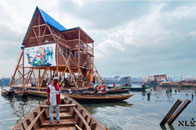
Buildings that float The sea level has risen roughly 20cm (nearly 8in) since 1870 and the rate of rise is accelerating. By 2100, the sea is projected to rise as much as 50cm to 2m (22 to 79in), according to aliterature reviewby the US National Research Council.
The rising water and intensifying storms flood coastal cities, but there may be ways to adapt, such asthis floating school. The school is a prototype for architecture among rising coastal waters, built by the waterfront community of Makoko in Lagos, Nigeria. It is a three-level A-frame atop a floating platform built from discarded plastic barrels. The building is powered with renewable energy and harvests rainwater.
Indigenous architecture has a similar solution to changing water levels. The upper Amazon river in Peru rises and falls with the season and houses built on log platforms in Belen, a riverside community in the city of Iquitos, float with it. See examples at thisGoogle imagesearch.
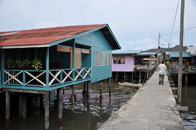
Design for flooding The coast floods in Buli Sim Sim, a Malaysian fishing village, so construction crews there have propped homes up on stilts. They may not know it, but the architects of this common solution are employing an example of “resilience planning,” meaning simply that they have designed with flooding in mind. Other examples include permeable streetsand parking lots and green spaces that can flood and absorb water.
Impoverished residents of Da Nang, Vietnam, are putting resilience planning into practice. Theyqualify for loansand train to retrofit their homes for flood and storm resistance.
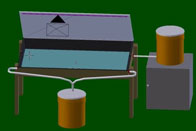
Water Desalination / Freshwater treatment Small islands and arid climates anywhere in the world can offset the climate's threat to their drinking water by treating seawater or contaminated water with a solar still. A state-of-the-art desalination plant like the one in Victoria, Australia, can churn out 400 to 500 megaliters per day and costs US $1 billion or more. But small-scale and do-it-yourself models may make sense for households in small communities. Themost basic solar stillis simply a plastic sheet over a bucket in a pit in the ground, but slightly more upscale versions can produce several liters of potable water per day under a sunny sky and you don't have to dig holes in the yard. These can supplement rainwater harvesting and household water treatment methods.
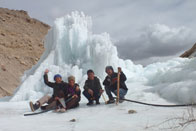
Artificial glaciers Glaciers are shrinking in the mountains above Ladakh, a high-altitude desert in the Indian Himalayas, and the loss of meltwater is drying up farms right at the start of the planting season. An experiment underway would solve the problem with artificial glaciers built close by the farms during the winter. Sonam Wangchuk and students at the SECMOL school made aprototype of an “ice stupa,”so-called because they resemble the religious shrines common to Ladakh and Tibet. To form it, the team piped water from upstream using gravity to deliver it to the top of the stupa as it froze and grew. Their two-story stupa contains an estimated 150,000 liters of water. More such stupas could fix their looming water crisis before it strikes.
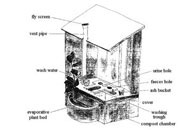
A Composting latrine for flood-prone areas A flooded latrine is a disgusting clean-up job and it's also a health hazard. Microbes in human waste escape into the groundwater to spread diarrhea and gut parasites. Increasingly powerful and unpredictable floods afflict coastal and riverside communities as the weather changes around the world, so designs likePractical Action's flood-resistant composting latrinecould be a good idea. The latrine sits above ground to avoid contaminating the water. It diverts fecal waste to a sealed composting chamber and urine and rinse water to a separate evaporative bed filled with plants.
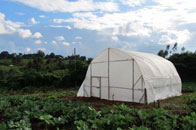
Better ways to farm Weird, new weather patterns, droughts and soil-eroding deluges are forcing farmers to look for better ways to grow crops. Terracing the land along topographical lines can level slopes and reduce erosion. And greenhouses allow farmers to grow crops year round in two-thirds of the time using only two-thirds of the water, and they can expect to see 20 percent better yields.
Thismodular and low-cost designmakes greenhouses affordable to farmers in developing countries. It's a project by Khanjan Mehta, an engineering professor at Pennsylvania State University and a contributing editor at E4C, and his team.
For variations on the theme, try astraw bale greenhousein our Solutions Library, or aseawater greenhousethat irrigates crops with treated seawater. And here's arepository of greenhouse construction guidesand research on viable crops.
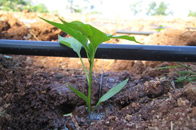
Better irrigation Irrigating a farm can double the amount of food it produces and buffer against dry growing seasons in a changing climate. In spite of that potential only 20 percent of farmland worldwide is irrigated,saysthe UN Food and Agriculture Organization. Low-cost pumps and efficient irrigation methods coming online now are making a difference in developing countries. Drip irrigation like the tube pictured conserves water and energy. For pumps have a look at a well-testedtreadle pumpdesign, newsolar pump prototypesand this riverwater wheelidea.
For more see our guide:Ten low-tech ways to irrigate crops.
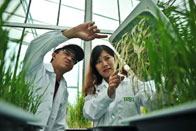
Resistant crops New and improved seeds that resist the conditions brought on by climate change are feeding the hungry. Genetically modified organisms are bad words in some circles, for better or worse. But here we're talking about improving seeds through breeding, not gene injection.
Better-known examples includesalt-tolerant riceand drought-resistant ricedeveloped by the International Rice Research Institute,and BioCassava Plus is working on amore nutritious cassavafor sub-Saharan Africa.
Also in development, asalt-resistant potatothat can thrive in high-salinity soils in Pakistan, and a salt-tolerantvariety of quinoafor farms in China, Vietnam and Chile, among others.
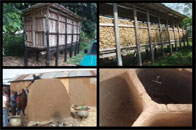
Crop processing and storage Machines that process crops and facilities to store foods can buffer farms against lean years and add value to the produce. As much as 10 to 40 percent of crops rot after the harvest when they're not stored properly, says Sam McNeill at the University of Kentucky. He and his colleagues have developedimproved grain storage facilities, each tailored to the regions where they serve.
The picture to the left shows examples of good and bad storage facilities. The mud silos in the bottom row are ideal for storing dried maizes in dry climates, and they are better at preventing losses to insects and theft than the bins in the upper row.
There may be at least one low-cost food processing machine for every type of crop and new ones come online often. Some that have caught our attention are thissolar dryer, thismechanical grinder for baobab fruit, thesesisal twine manufacturing machinesand thissorghum press.
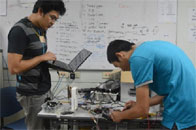
Landslide detectors Landslides can bury and kill whole communities with no warning, but their element of surprise might be a thing of the past. Joel Marciano and a team at the University of the Philippines is developing a landslide sensor and warning system. The devices are tubes up to one meter long stuffed with a tri-axial accelerometer to detect land movement and with a moisture sensor to report on the soil conditions. The tubes are buried into boreholes on suspicious-looking slopes and they are powered either through the grid or through solar panels on site. They report out over a cellphone network to warn authorities that a landslide could be imminent.
Permission granted by Engineers 4 Change to reprint



